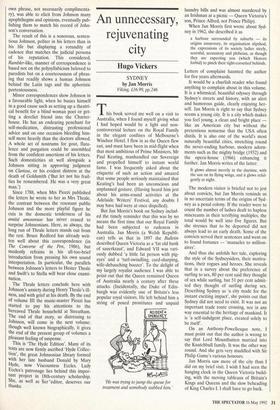An unnecessary, rejuvenating city
Hugo Vickers
SYDNEY by Jan Morris Viking, £16.99, pp.246 This book served me well on a visit to Australia, when I found myself giving what I had hoped would be a light and non- controversial lecture on the Royal Family in the elegant confines of Melbourne's Windsor Hotel. I flew in as the Queen flew out, and must have been in mid-flight when that most ambitious of Prime Ministers, Mr Paul Keating, manhandled our Sovereign and propelled himself to instant world fame. I was frequently asked about the etiquette of such an action and amazed that some people seriously maintained that Keating's had been an unconscious and unplanned gesture. (Having heard him jest about his arms-round activities at the Adelaide Writers' Festival, any doubts I may have had were at once dispelled).
But Jan Morris's book on Sydney includ- ed the timely reminder that this was by no means the first time that our Royal Family had been subjected to rudeness in Australia. Jan Morris (a Welsh Republi- can) tells us that in 1897 the Bulletin described Queen Victoria as a 'fat old hunk of sauerkraut', and Edward VII was vari- ously dubbed 'a little fat person with pig- eyes' and a 'turf-swindling, card-sharping, wife-debauching boozer'. To the delight of my largely royalist audience I was able to point out that the Queen remained Queen of Australia nearly a century after these attacks. (Incidentally, the Duke of Edin- burgh was evidently one of Britain's less popular royal visitors. He left behind him a string of poxed prostitutes and unpaid 'He was trying to jump the queue for treatment and somebody stabbed him.' laundry bills and was almost murdered by an Irishman at a picnic — Queen Victoria's son, Prince Alfred, not Prince Philip).
When Jan Morris first wrote about Syd- ney in 1962, she described it as
a harbour surrounded by suburbs — its origins unsavoury, its organisation slipshod, the expressions of its society ladies steely, scornful, accusatory and plebeian, as though they are expecting you (which Heaven forbid) to pinch their tight-corsetted behinds.
Letters of complaint haunted the author for five years afterwards.
It would be a churlish reader who found anything to complain about in this volume. It is a whimsical, beautiful odyssey through Sydney's streets and history, with an alert and humorous guide, clearly enjoying her- self. Jan Morris is right to say that Sydney seems a young city. It is a city which makes you feel young, a clean and bright place — like an American city but without the pretentious nonsense that the USA often distils. It is also one of the world's most naturally beautiful cities, stretching round the never-ending harbour, modern adorn- ments such as the mighty bridge (1932) and the opera-house (1966) enhancing it further. Jan Morris writes of the latter:
It glows almost merrily in the daytime, with the sun on its flying wings, and it glows reful- gently at night.
The modern visitor is briefed not to jest about convicts, but Jan Morris reminds us in no uncertain terms of the origins of Syd- ney as a penal colony. If the reader were to count the number of lashes dealt to hapless miscreants in their terrifying multiples, the total would be well into five figures. But she stresses that to be deported did not always lead to an early death. Some of the convicts served their sentences and went on to found fortunes — 'manacles to million- aires'.
And thus she unfolds her tale, exploring the style of the Sydneysiders, their motiva- tions, their rogues and heroes. She reveals that in a survey about the preference of surfing to sex, 80 per cent said they thought of sex while surfing, but 51 per cent admit- ted they thought of surfing during sex. Describing Sydney as 'a city made for the instant exciting impact', she points out that Sydney did not need to exist. It was not an important trade route crossing, nor in any way essential to the heritage of mankind. It is 'a self-indulgent place, created solely to be itself.
On an Anthony-Powellesque note, I must point out that the author is wrong to say that Lord Mountbatten married into the Knatchbull family. It was the other way round. And she gets very muddled with Sir Philip Game's various honours.
Jan Morris saw more of the city than I did on my brief visit. I wish I had seen the hanging clock in the Queen Victoria build- ing, with the moving tableaux of Britain's Kings and Queens and the slow beheading of King Charles I. I shall have to go back.


















































 Previous page
Previous page